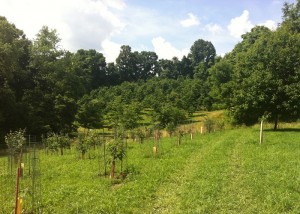Blaming Climate Change for Pests in PA Forests
From the Allegheny Front (Environmental Radio), Pittsburgh, August 7, 2014
By some estimates, forests can absorb 24 percent of man-made carbon dioxide emissions a year. To get those climate benefits, many experts say forests need to be well-managed—against droughts, bugs and invasive plants. But climate change is making these problems worse.
John Burnham’s tree farm is in southwest Pennsylvania. He’s growing American Chestnuts, to see if a hybrid of the endangered tree can survive.
Burnham also has a 100-year-old stand of yellow poplar that’s ready to be cut and sold. “I probably get a letter or postcard every six months by someone who wants to help me manage the timber,” Burnham says. “Basically, they want to cut the trees.”
Burnham worries that if he cuts the poplars, the land will be overtaken by invasives, weeds like the Asian ailanthus, also known as tree of heaven, known for its quick growth and foul smell. “I think we would lose control of the next woods that’s there, and it might be centuries before we would get back to a woods that we would be pleased with,” he says. Burnham is concerned that if invasives take over, it could harm the native birds, bees and bats.
Tom Martin is president of the American Forest Foundation, which advocates for sustainable family woodlands. “Used to be, if you owned land, and you let nature take its course, you’d probably get all those wonderful things you wanted in terms of wildlife, water,” Martin says. “These days, though, climate change, pests and pathogens, bugs and disease, are really taking a toll on your forests. So unless you’re actively paying attention, you can lose what you love.”
In recent years, tree farms in the Pennsylvania region have suffered from an increase in invasive plants and bugs. In the south, devastating tornadoes have knocked down large swaths of timber, and out west droughts have been tough on woodlands.
Martin says these problems are getting worse. “Perfect example is the mountain pine beetle. We’ve had it for a very, very long time in the United States. It’s an endemic beetle, I don’t know when it first came here,” he says.
Martin says the mountain pine beetle is currently destroying virtually all of the lodgepole pine in parts of Colorado and Wyoming. “Why? What’s suddenly changed that it’s gone from a nuisance to a disaster?” Martin asks.
He blames climate change. “What’s changed is there aren’t the number of extremely cold days in the winter in row that knocks back their population. It just isn’t happening anymore. So that pine beetle which used to do nuisance level damage suddenly is doing massive damage to a whole species of trees there and is now moving into the black hills and hitting ponderosa pine.”
Those warming temperatures are also benefitting some unwanted plant species, says Lewis Ziska, a researcher with the U.S. Department of Agriculture. He has a book coming out about how plants react to rising temperatures and levels of carbon dioxide.
“In nine of the ten field studies, all of them show that as you change the environment, specifically as you add more C02 or a warmer temperature, it’s the invasive species that respond,” Ziska says. “And that has huge ramifications.” Ziska says research finds that invasives, such as poison ivy and ragweed, thrive under higher temperatures and levels of carbon dioxide.
It’s James Finley’s job to talk with large landowners about this and other issues relating to climate change. Finley is a professor of forest resources at Penn State University. He says the more native trees and other species that survive, the more forests will be useful in sequestering carbon dioxide and reducing the impacts of climate change.
But he says many landowners are similar to John Burnham—they’re doubtful about climate change. “Can I say global climate change to you? Probably not and keep you in touch with where I am,” he says. “But I can at least begin to point you toward making decisions toward a healthy ecosystem, which is going to be more resilient. And so I’m asking you to play off the idea of stewardship, rather than the idea of global climate change.”
And that’s how John Burnham thinks about it—he’s doing what he thinks is best for his trees and ecosystem of his property—and it’s fine with him if that benefits the climate.

